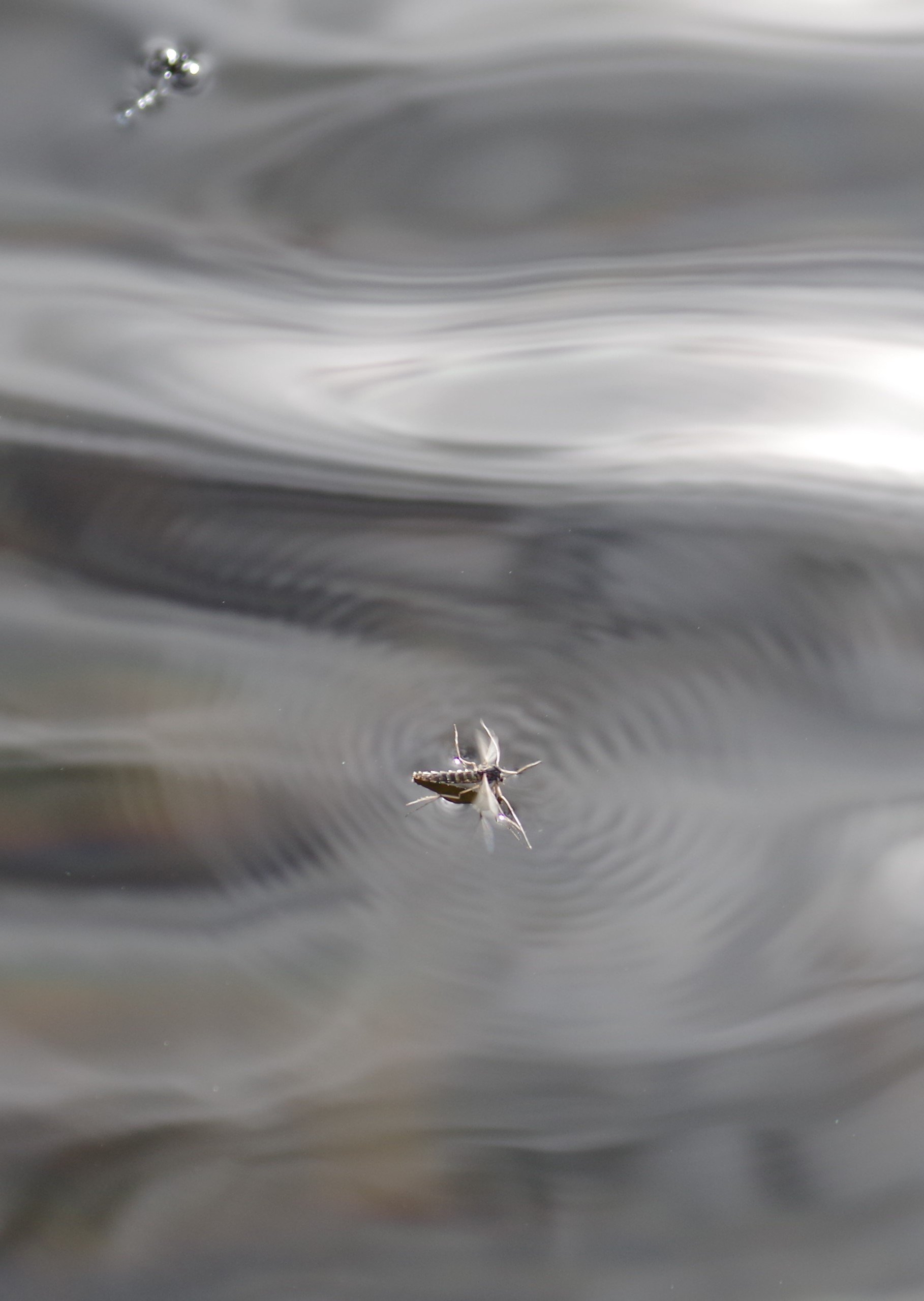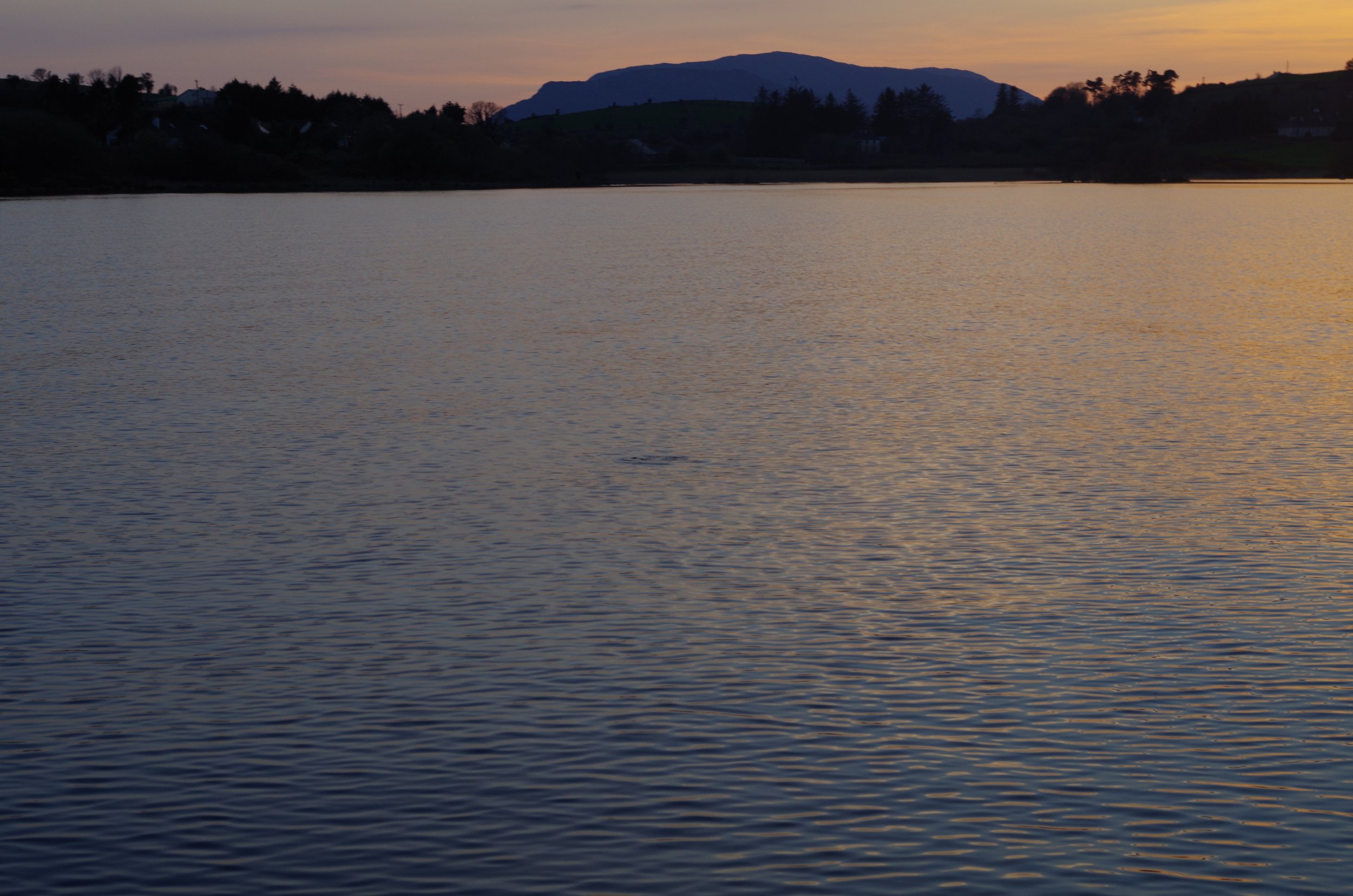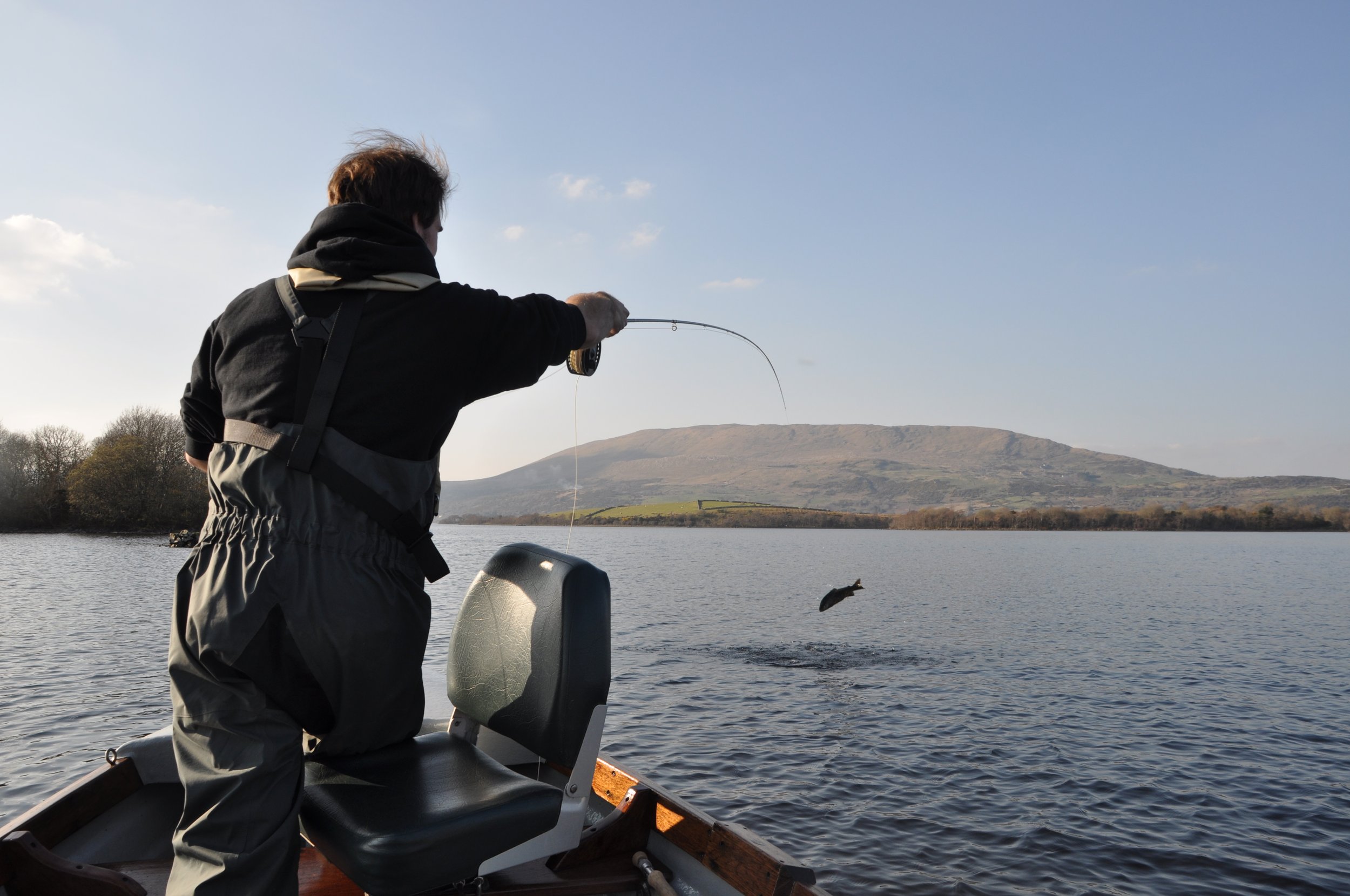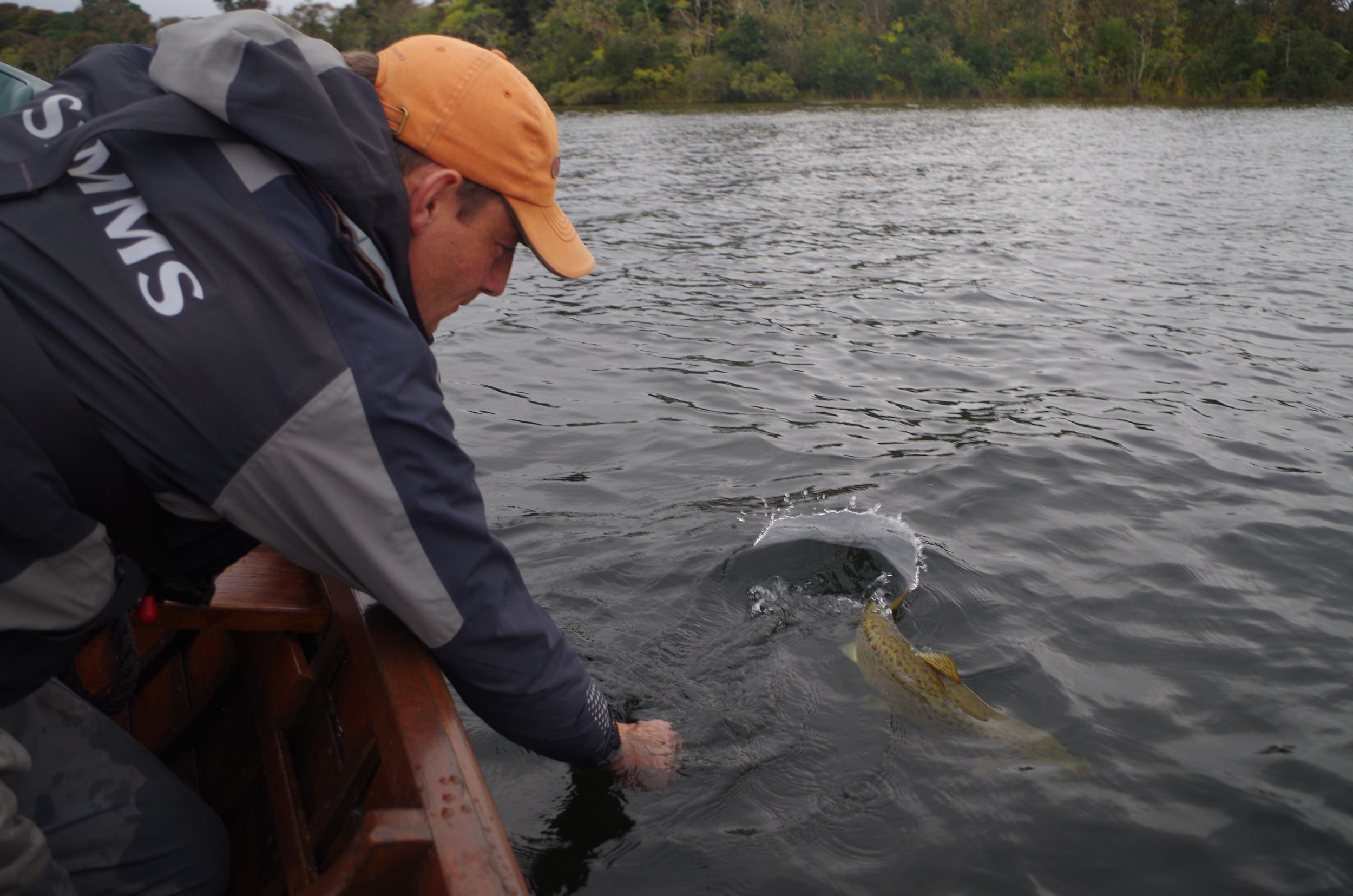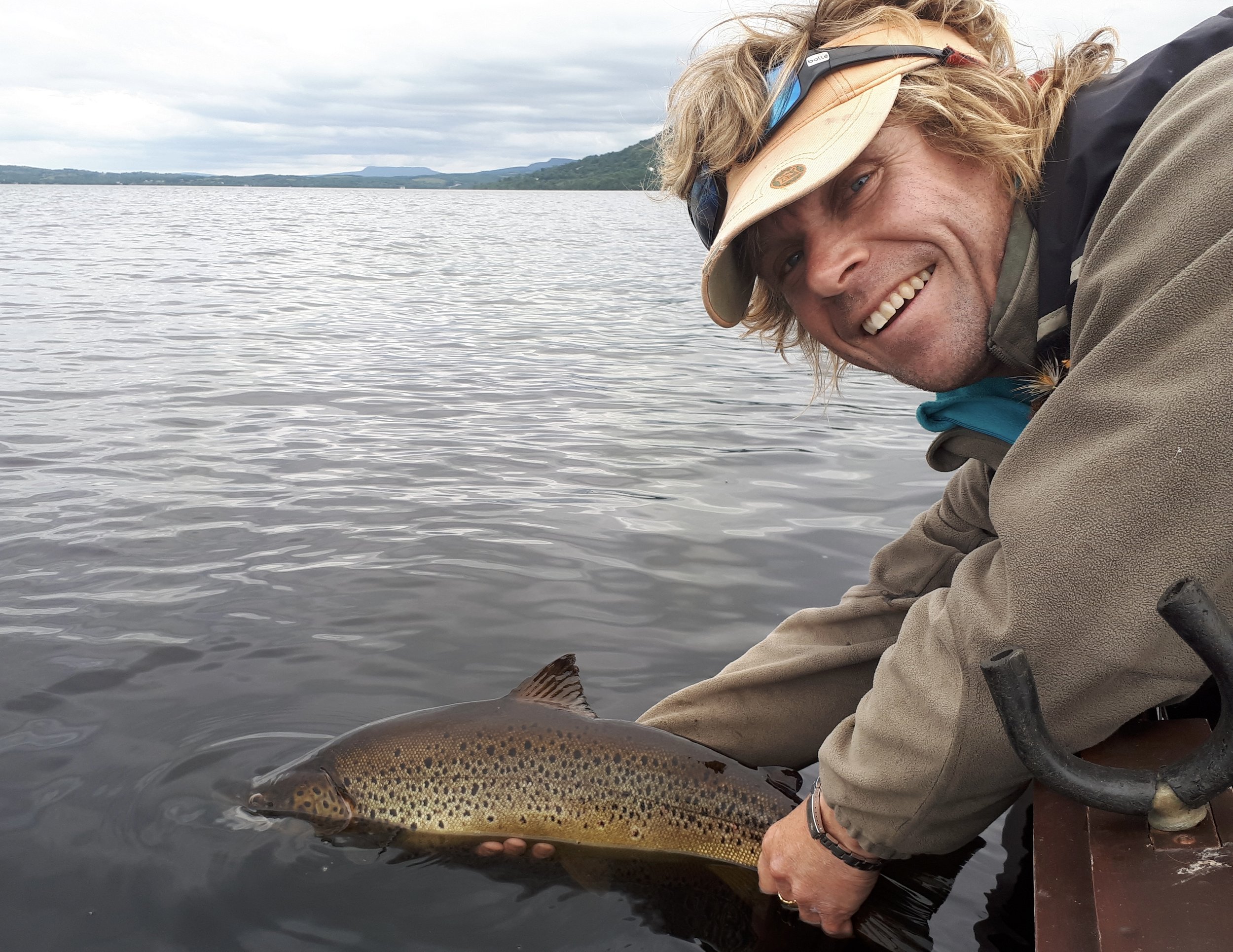
Tom Doc Sullivan
Fishing the Dry Fly (On the Irish Loughs)
There are a lot of things unique to Ireland, as indeed there are to many nations. However, while other countries have lakes, we in Ireland have Loughs and while to mere ordinary folk a Lough is just a phonetical translation of the Irish word for lake to the trout fly angler it conjures up a whole different world, one of wild, indigenous Brown Trout.
While fishing the Dry Fly on a lough has a lot of different aspects to it than that of a river, it still involves getting your quarry to take a fly of the surface, simple as that and of course, simple is good. Just that we know, trout fishing on the loughs in Ireland is primarily from a boat. There is a long history of fishing the dries on the lakes and for ease I am going to break it down into two methods, Stalking mode and Drifting mode, both are dry fly methods but there are slight differences between the two. Stalking mode has been fished in Ireland for well over a hundred years, it has been used for Spent Mayfly and Green Peter Sedge fishing. IT is primarily done at evening time in calmer conditions, targeting fish that are moving to flies. There are times on windless days, which don’t happen too often in the West of Ireland, that we would be using this method for the whole day. The second method we have is the Drifting method, this is a more recent development and is a natural progression from the tradition of drifting under the power of wind, initially dapping natural flies with long rods and then onto casting artificial flies out and retrieving them back as wet flies to where we are now with fishing dries in open conditions, often doing this in quite large waves.
1. Choice of equipment
The tradition is to fish longer rods from boats on the loughs, for a couple of good reasons. Our boats are designed to accommodate two fly fishers comfortably, no more. Rods are casting from a sitting position so head clearance is important especially if there is also a guide in the middle of the two rods. In or around 90% of anglers are right-handed so this entails that one rod will have the inside arm and will have to clear the two heads. You can see in the picture, a very young me is at the stern of the boat fishing the inside arm. If clearance isn’t being achieved then problems will arise. Miko Burke, was an old Gillie from Inishdooras, an island on Lough Corrib in my home parish. Many years ago, he had two not so experienced rods out with him in the boat, their casting was not going smoothly so, needless to say Miko was not too enamoured with the proceedings. After removing one of their flies from his hat for the umpteenth time he uttered, ‘Man! It’s God damned bucket I would want on my head today’. Miko is long gone to the Big Lough in the sky but his saying lives on amongst us here in Dooras.
The longer rod also is an advantage for fighting a trout particularly a fish that runs to the side of or behind the boat. I will touch on this later in the fighting of fish. The minimum length you can fish comfortably with from a boat is at least 9’ but 9.5’ is better and 10’ ideal.
My favourite rods? I can narrow it down to two; 10’ #5 for my stalking and 10’ #6 for my drifting, between the two the #5 weight is my favourite. Why then do I use the #6 weight for the drifting style? The answer is power, when fishing on the drift, we can be out in winds of 30km/h and sometimes more, the heavier weight rod makes for easier fishing on the back cast but more importantly if a trout should move to your side, you will have the power to punch a line across the strong wind and cover the fish successfully. I do occasionally fish a 9’ and 9.5’ rods and do have a fondness for a Hardy Zenith 9’ #5 for stalking occasionally. I have fished both #4 weights and #7 for dries. Before you recoil in horror at me fishing the #7 let me explain; in some competitions you are only allowed one rod made up at any one time so if fish turn on to dries and you have to change tactics quickly then the #7 rod must do. Just remember not to strike too hard.
With regards to using lighter rods on the lakes I don’t see the need to, my buzz is in the take and I want to get the fish in as quickly as possible after that. On another note, I have seen people using #3 weights who were playing the trout way too long resulting in the fish being very stressed on release. Not everyone is able to bully a trout on light tackle and the fish suffers for this.
With fly lines the most important thing is a good presentation taper, I find the standard of most top end fly lines are prefect for what we need, a good caster will make do with any line. The price of a top end fly line would get you an hour or two with a professional instructor.
For my eyewear I go for non-polaroid amber or yellow shooting glasses. I don’t use polaroid for dries because they take away the glare from the surface and doing this lessens the visibility of your fly, remember your fly will have no glare so if it is sitting in the middle of glare, it is easier to pick out. My take detection improved after I started using these.
My other most important is my amadou patch, I go through one a year. I do use powders both for drying and for floating but my go to floatant is Gink.
On the clothing side, full armour! When you are in a boat on the Lough you are exposed to all elements so, plenty of layers and 100% waterproof.
2. Leader Material, build up length and knots
Bear in mind that it is quite common to fish two dries for both methods here and some anglers will use three, I don’t like it personally but have fished with competent anglers who do. I will cover why I like to fish two flies later in ‘presentation’.
My maxim for tippet strength is go as heavy as you can, I abhor leaving flies in fish.
For my stalking I use a tapered leader on my #5 weight set up, I have started to use 8’ floating polyleader attaching a ring at the 2x end. This allows me to attach various diameter of tippet from 3x through to 7x from then on. For my drifting dries, I am not so elaborate, for the most part I dispense with the tapered leader and go straight through. My standard set up for this is a leader 16’-20’ in length split in half. So, on a 16’ foot leader I would be 8’ to first fly and 8’, on a 20’ foot set up 10’ and 10’ and so forth (see diagram). I do on occasion, use a 10’ tapered to 2x leader to my top fly.
The size of the fly and conditions dictate tippet strength, on a good windy day with wind speeds of 25km/h during the Mayfly, my fly size would be #10s or even #8s here I will use straight 2x but for Lake olives in the same conditions I would go down to 3x, maybe 4x as the flies are #12 and then for example on hatches of Duckfly which are a #14 I would go down to 4x occasionally 5x. I tend not to go below 5x on the drifting method. For Caenis (#18/#20), which is primarily stalking I will go down to 6x and even 7x.
I use a variation of the 3-turn water knot for my dropper, this makes changing my bob fly much easier. The only time I vary this and use a New Zealand style connection is for my night-time Mito fishing (see diagram). Two reasons for this, it is far less susceptible to tangles which are a nightmare in the dark and secondly, I only use one type of pattern for Mito so, I will not be changing it.
It is commonly held that we go for co-polymer for Lough style dries, the general belief is that as co-polymer is less dense than fluorocarbon it will not sink as quickly and pull your flies down. While I understand this, I have reverted to using to fluorocarbon for my drift fishing. With the drifting method, you are doing a lot more blind fishing (I will cover this under presentation) so when fishing thus I do not like to leave my flies longer than 15/20 seconds in one spot, I find that most takes occur within that time frame. Therefore, the fluorocarbon sinking should not be an issue. There are however occasions to change to co-polymer, when drift fishing in a big wave the fluorocarbon sits well down and then as the flies ride to the top of the wave you actually will experience drag as the fluorocarbon pulls against the fly (see diagram).
3.Approach and Stealth.
Wild Browns have a survival instinct and to be honest stocked trout develop the same survival instinct as well. Approaching an area to fish with a boat is no different to approaching a run on a river. You would not walk down along the bank of the pool which you were about to fish upstream. The same goes for the area you would like to fish on the Lough, approach from far out, wide and slowly, do not motor over the area you wish to drift over.
Fish can turn off once a boat has drifted over them, I have a name for it here and I call it ‘second drift syndrome’. There have been many occasions that on having a successful drift on a choice area, I will do it again and move nothing, my preferred option is to rest that particular drift and return later. However, there is another adage which is, never leave rising fish, passed on to me by my father. It is a matter of weighing up whether there are enough fish active or so much food present there that the fish will stay feeding or not. On these decisions, the guide earns his crust.
When stalking, a steady, quiet pair of hands on the oars are a must, otherwise an electric engine is a Godsend. The less clutter in the boat as well makes for less chance things dropping on floor of the boat, this is a no-no. Try to avoid body motion when casting, if you think there are no consequences from this, a boat floating in flat calm water will soon let you know if you are moving your body as you can witness a cascade of mini tsunamis issue forth from it.
4. Reading the water
If rivers are poetry, then the loughs are prose. I genuinely prefer prose but poetry gets all the kudos. There are so many aspects of reading the Loughs that it is genuinely hard to cover in a snapshot. It is daunting for some anglers, particularly river anglers when they see a large body of water before them.
I look for features, promontories, bays, islands, shallows, skerries reedbeds and so forth. Then take into account wind direction and where that will enable us to drift fish these spots correctly. Check the windward shoreline what flies are stuck in the foam, check the water for evidence of hatches, shucks etc, the wind lanes on the surface have a tale to tell. Shake the bushes by the water. Watch for seagulls, if you see them hovering and flying over the water, they are feeding on flies and for Seagulls to feed on flies entails a good hatch. Swallows and Martins tell tales too but they do not need as big a hatch to come on the water. If the gulls are swooping over the trees on the islands and shorelines then they are feeding on spinners.
So as some people just see reams of text as the look out on a vast piece of water the seasoned lough angler sees the day as a story, the prologue, the main plot, the sub plot, the surprising twist, the intricate tale that lies ahead and hopes for a decent epilogue.
5. Casting ability which casts are essential.
A skilfully handled boat will negate the need for difficult casting, especially for the drift method. I would say however that an ability to double haul is an advantage. In very calm conditions the trout can be incredibly spooky and wary of the boat and the extra distance is a huge advantage, especially when stalking. Also, I find that competency in double hauling ensures much better presentation on the medium length casts as you can kill the forward motion at the right moment to ensure a precise turnover. Also, I mentioned earlier the ability to punch a line across a strong breeze, there has to be power in the cast to cut through the wind.
6. Entomology, what should we know.
The Loughs are no different to a river and are host to a vast array of fly life, trout soup to us anglers! Therefore, entomology is rather akin to casting, if you don’t have a basic comprehension of it then you will suffer like you will from poor casting. However, expanding your knowledge to thesis level will not guarantee you more fish. Here’s the thing though, if it increases your enjoyment of fly fishing then, fill your boots! This is the beauty of our sport that there are so many different enjoyments that each individual can take from it.
The loughs here hold all the basic forms that concern the fly fisher, Diptera, Ephemera, Plecoptera and Trichoptera. I suppose it is the Ephemera class that my own lough, Corrib, is famous for, the Mayfly (ephemera Danica) but we have others of this family that are important too, the Lake Olive and Caenis. After these it is between Diptera and Trichoptera as to level of importance, I would say Chironomids are probably more important for the dry fly angler but that’s on account of my love for the Mito Buzzer which leads to spectacular evening time dry fly fishing. While others no doubt would place Sedges in the next ranking of importance
There is a host of information we can gather and use from our observation on flies that determines how we fish dries. Newly hatched Duckfly (our first relevant midge/chironomid hatch) do not stay as long on the water’s surface and when they do are more inclined to skate around. They are more vulnerable in the pupa and emerger stage so that is when they are the focus of the trout. It is when they return as egg layers that the trout feed heavily on them. Lake Olives on the other hand are almost the polar opposite for the dry fly angler. On hatching they tend to remain on the water’s surface and will use wind power to assist them to the shoreline, ergo trout will take them as they are an easy target, whereas they do not figure as large at the spinner stage in the fish’s radar. So, from that you will find that in my fly boxes I have a big range of imago lake olives compared to a small range of adult Duckfly.
7. Rise forms Can they tell us something?
Reading the rise in while stalking in calmer conditions is important as you have to determine which way the fish is moving; this is an absolute must. When the fish are really on the go on a still surface then this task becomes easier as you can see the trail they are following, more of this later.
This is not as important with drifting style for the following reason, fish tend to face upwind when there is a breeze blowing. This is akin to facing the flow in a river so as to intercept foodstuff. So, if there are flies being blown along the water’s surface if the trout wants to feed it must face into it.
Some rises and water disturbance are not from fish taking off the surface a very easy way to explain this is when sometimes we see a big displacement of water when a fish takes the wetfly on an intermediate line and we know for sure that the fly is subsurface. As a rule, the splashier the rise the more likely it is to be a surface take, but on quieter rises if you see the fishes head or mouth then chances are it is a surface take. The dorsal fin on view can be a different story and needs close observation to see if they are feeding sub-surface or not.
There is a type of rise almost peculiar to the adult olive, a very splashy rise where a plume of water gets pitched to one side. I think it is one of the most exciting things in fishing the loughs when on a drift you see one of these rises over a hundred metres away or more (they are very easy to see), as the drift continues another rise in the same spot but this time you are only eighty metres away then again at forty metres. You are primed, don’t panic, keep your powder dry. Then as it is only twenty metres away you land your point fly on where the other rises have been (you think so anyway), three days pass, well it seems like that but it is only five or ten seconds but now you are wondering whether you should recast, maybe you got the bearings wrong, then the exact same rise form explodes on your point fly, you give the rudimentary pause, lift and it all goes solid! That’s a little bit of Heaven!
8. Fly selection, size, shape, materials, which flies are essential, favourite fly.
This is not being flippant in any way but the fly that works!!
I have a couple of experiences that tells me that the actual fly is only a part in the mix for success, both of which happened to me in competition fishing. Fishing the World Cup in Lough Mask twenty years ago we were approaching a drift in the morning shortly after going out. The boatman, Andrew Boyd, said to me as we neared the spot that the fish were on dry sedges, the Welshman’s Button. I had a team of wet flies on an intermediate line. So, I changed quickly to a floating line but while doing it I could see fish moving steadily, impetuosity got the better of me. So, rather than make up a new cast of dries I took off the middle fly, I had left up two classic Irish Wets, the Green Peter and the Golden Olive Bumble both in #12s so I just ginked them up. The rise lasted 30 minutes and in that I got to cover four fish and boated two of them both big fish which helped win the heat that day and also one of them won the biggest fish of the 5-day event.
Another occasion we were fishing the Irish heat of the Peregrine Team event, definitely over 20 years ago. The heat was being fished on Lough Corrib, I left the start point at Greenfields that morning and motored to Dooras which was 40 minutes and 12 km away. When I arrived, disaster! I remembered I had left my dry mayfly box on the roof of my car. Not to worry I thought, I would catch on the wets. As the day wore on a hatch of Mayfly started and fish started to move to them but ignored my wets. I picked out two wet mayflies from box, a lough arrow and one of my own patterns ginked them up. I landed four fish on my dry wets and helped our team qualify for the final later that year in Rutland.
I also find that patterns come in and out of style and success from year to year and interestingly, when they do they will work in other loughs not just one.
Size, colour, shape in that order.
9. Presentation and drifts.
So, as you have no doubt garnered by now, drift has a completely different meaning on the loughs, it involves the boat being pushed along with the wind. So, as I have mentioned in rise forms, if the boat is being pushed along by the wind, then so are food items, in the same way a trout will use the flow of water to get food on a river, the trout will use the wind on the lake.
When drifting you are working the water in front of the boat from you, as the boat is being moved along you are being presented with fresh water every two or three casts depending on the strength of the wind. As I said earlier a skilfully handled boat will help you cover the best spots on a drift. Quite often when drifting we are fishing blind, covering the water in front. I find when doing this that, as opposed to continually casting down the line in front of you that I prefer to fan the water. I will initially cast straight out, fish my dries for fifteen to twenty seconds then switch a couple of metres to the left (or right depending) then next cast almost 45 degrees angle then I revert to straight down the line again.
A big mistake a lot of anglers make when on the drifting dries is they fish to long a line. I find 15 metres is more than enough in windy conditions. The aim of the game is to catch fish, the longer line you fish the more difficult it can be to set the hook. Ok, if you see a trout moving at 20/25 metres, he must be covered but you are primed and ready if he takes. After that revert to the shorted cast.
One of the reasons that the two-fly approach is popular is thus. Trout generally do either one or two things when feeding in windy conditions.
One is they remain stationary waiting below the conveyor belt or secondly, they will be moving upwind to intercept the flies. If you have a two fish cast and a trout moves in front of you then by landing your point fly on the rise you cover situation one but your bob fly then you are covering situation two, either option with this presentation In calm conditions while stalking then yes, accuracy is crucial as is delicate presentation, if you are not ticking these two boxes then you won’t be at the races. It is important to judge the lead when presenting a fly. For example, when fishing the spent Mayfly, the distance between each take by the fish can be quite a bit, a metre sometimes two and even more, however for the evening buzzer, the Mito, the distance between each rise is more often less than a metre The Mito is my favourite.
10. Upstream or downstream.
This is not a factor on the Loughs other than to say when drift fishing you will always fish with the wind at your back. I would add that casting behind the boat tends not to be productive as you are covering water that the boat has gone over and you will also be casting into the wind.
11. Fighting fish
Fighting a trout from a boat takes a bit of getting used to. My preference is to play the fish hard and subdue him as quickly as possible. If there are two rods fishing in the boat then there is team work required. As we know we cannot always control the direction the fish runs so in this scenario the inactive rod must get his line out of the way as quickly as possible to avoid any entanglement. If a trout is running to the opposite end of the boat from you or behind the boat then often there is no alternative other than to put your rod tip in under the water below the boat’s draft so the line clears the keel and engine. If you have to resort to this, remember that once in under the water the flexibility of the rod is lessened somewhat so you have to be more sensitive with your line hand. Also, it goes without saying be extra careful of this manoeuvre in very shallow water.
Traditionally, in the old days fish were brought to the back of the boat (side facing the wind) and with the longer rods were swung into the waiting net, this was a hangover from dapping. However, I personally prefer to play fish quickly and into the net at the front of the boat.
* I stick with imperial measurement for rods and leader length as most rods here are still measured in feet, I tend to stick with that as I do with leader length on account of it being easy to measure alongside the rod.
Diameter conversion for Fulling Masterclass Fluorocarbon which is the tippet I use for dries, excellent stuff in my opinion
2x 0,235 mm
3x 0.196 mm
4x 0.185 mm
5x 0.157 mm
5,5x 0.143 mm
6x 0.125 mm
7x 0.110 mm









